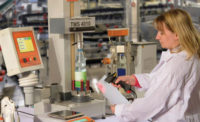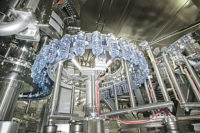Process automation equipment focuses on hygiene, security
Beverage companies benefit from equipment's speed and adaptability

Speed, ease-of-use and flexibility are paramount for today’s processing automation equipment, experts note. (Image courtesy of Siemens Industry Inc.)
With the memorable theme song opening of “shlemiel, SCHLEMAZEL!, Hasenpfeffer Incorporated,” TV’s “Laverne and Shirley,” closes with the two friends “doing it their way” on the bottling line of Milwaukee’s fictitious Shotz Brewery. Although manufacturing facilities’ beer-capping lines have changed, speed, ease-of-use and flexibility are paramount for today’s processing automation equipment.
With myriad SKUs and new technologies, including improvements to clean-in-place (CIP) systems, beverage manufacturers are moving from batch processes to continuous mix processes, reducing the size or eliminating the need for finished product storage tanks, according to John F. Butts, controls engineer at SMB Machinery LLC, Ball Ground, Ga.
“CIP systems ensure that all surfaces and components of the process that come in contact with the product or ingredients are sanitized to the specifications required,” he says. “This ensures that only recipe-specified ingredients are introduced into the process.”
Yet, before ingredients can be added, processing equipment needs a secure platform platform — Ethernet — for operation, experts note.
The use of Ethernet to power a plant’s communications network has a major impact on processing automation equipment because it provides a flexible architecture and alleviates a proprietary network topology, says Ed Montgomery, industry manager at St. Louis-based Siemens Industry Inc.
“We all know the Ethernet is the backbone of the Internet, but quite too often the customer gets the two intertwined and creates security vulnerabilities on the plant floor,” he explains. “To alleviate security concerns, Siemens has developed a line of Ethernet Security modules named Scalance F to protect the plant floor from Internet attacks.”
Installing an Ethernet backbone into a plant’s control system provides endless possibilities — and top-level security, Montgomery notes. “Siemens has a full line of highly integrated automation products to meet the needs of the customer — from a simple [programmable logic controller] (PLC) to an advanced [distributed control system] (DCS),” he says.
Montgomery adds that Siemens’ process automation equipment is suited for various hygiene processes such as CIP, in which a manufacturer can ensure the cleanliness of the pipes — inside and outside — and record the process, thereby ensuring hygienic equipment. “Hygiene at any beverage plant is on the forefront of everyone’s mind,” he says.
SMB Machinery’s Butts says that ingredient formulations can impact a beverage’s viscosity and are providing different challenges. “The [beverage] industry should develop new sensors and procedures that will adequately measure the impact of a new ingredient to a process,” he explains.
However, automation remains beneficial for operations managers for several reasons. “Automation enables staff to concentrate on manual tasks and quality control as opposed to constantly manually monitoring the process; this results directly in a higher output per labor-hour as well as better quality of the final product,” Siemens’ Montgomery says.
Tracing the root cause
Additionally, tracking quality control, material consumption and costs are vital to processing operations. Siemens provides a complete line of process instrumentation, PLC- and DCS-based integrated systems as well as lifecycle management products for the front office to keep track of these measures. “We also supply a complete tracking and tracing portfolio that will allow the customer to trace their products from the farm fields to the store shelves and everywhere in between; so if there is a product defect or recall, the exact problem can be identified and sourced to the root cause,” Montgomery adds.
Enabling beverage companies to quickly and easily adapt formulations for diverse products is an important component of processing equipment’s ability to adapt to changing conditions. “A formulation can increase the viscosity of the product,” Montgomery explains. “Therefore, the pumps will draw more current, the flowmeters will respond differently and the agitators will require more power to adapt to the increased viscosity.
“All of the current consumption is traced with the Simofcode and our various types of variable-speed drives provide the control system and the reporting system with information on the actual production floor and be able to track the actual values of the increased demand on the process equipment,” he continues. “Flexibility is key for any manufacturer to increase their equipment availability and therefore, increase their bottom line.”
SMB Machinery’s Butts echoes similar sentiments. “Having a robust recipe manager and state-of-the-art processes will reduce or eliminate reconfiguration downtime,” he says.
Butts foresees that a continued proliferation of new products with short lifetimes and a more healthful product mix — often mandated by federal or local governments — will drive future innovations for processing automation in the beverage industry. “SMB will continue to strive to produce systems that minimize the efforts required to bring new products to market,” he says.
Looking for a reprint of this article?
From high-res PDFs to custom plaques, order your copy today!









